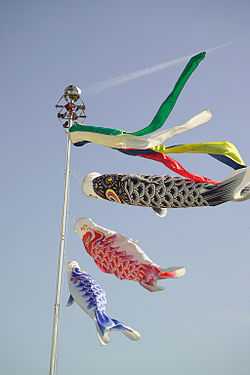Koinobori



Koinobori (鯉幟), meaning "carp streamer" in Japanese, are carp-shaped wind socks traditionally flown in Japan to celebrate Tango no Sekku (端午の節句), a traditional calendrical event which is now designated a national holiday; Children's Day.[1] These wind socks are made by drawing carp patterns on paper, cloth or other nonwoven fabric. They are then allowed to flutter in the wind. They are also known as satsuki-nobori (皐幟).
Children's Day takes place on May 5. Landscapes across Japan are decorated with koinobori from April to early May, in honor of sons and in the hope that they will grow up healthy and strong.
Description
A typical koinobori set consists of, from the top of the pole down, a pair of arrow-spoked wheels (矢車 yaguruma) with a ball-shaped spinning vane, flying-dragon streamer (飛龍吹流し hiryū fukinagashi) that looks like a windsock, a black koinobori and a red koinobori. If more boys are in the household, an additional blue, green and then, depending on the region, either purple or orange koinobori are added. The red koinobori's color can be varied as pink. These carp sets are flown above the roofs of houses with sons, with the biggest (black) koinobori for the father, next biggest (red) for the mother, and ranging down to the smallest carp for the youngest son.
These koinobori range from a few inches long to a few meters long. In 1988, the 100 m long koinobori weighing 350 kg was made in Kazo, Saitama.
Koinobori song
A famous Koinobori song often sung by children and their families. It was published in Ehon shōka haru no maki (Picture Songbook, Spring) in 1932. The lyrics are by Miyako Kondō (近藤宮子), the composer is unknown.
| Standard Japanese | Hiragana | Rōmaji | Translation |
|---|---|---|---|
|
屋根より 高い 鯉幟 |
やねより たかい こいのぼり |
yane yori takai koinobori |
Higher than the roof-tops are the koinobori |
See also
- Dragon Boat Festival
References
- ↑ "Trend Illustrated Japanese-English Dictionary of Things Japanese", Shogakukan, 1999
External links
![]() Media related to Koinobori at Wikimedia Commons
Media related to Koinobori at Wikimedia Commons